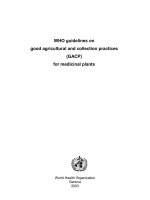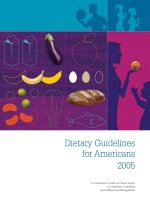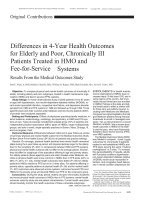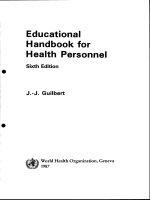Reproductive Technology for Dairy Cattle ppt
Bạn đang xem bản rút gọn của tài liệu. Xem và tải ngay bản đầy đủ của tài liệu tại đây (2.73 MB, 33 trang )
Reproductive Technology
Reproductive Technology Reproductive Technology
Reproductive Technology
for Dairy Cattle
for Dairy Cattlefor Dairy Cattle
for Dairy Cattle
Contents
ContentsContents
Contents
1.
1.1.
1. Anatomy of Reproductive Tract
Anatomy of Reproductive TractAnatomy of Reproductive Tract
Anatomy of Reproductive Tract
2.
2.2.
2. Basic Reproductive Phisiology
Basic Reproductive PhisiologyBasic Reproductive Phisiology
Basic Reproductive Phisiology
2-1 Puberty
2-2 Hormonal Control
2-3 Estrus Cycle
2-4 Follicular Wave
2-5 Heat Detection
2-6 Fertilization & Embryo Development
2-7 Optimum Insemination Timing
3.
3.3.
3. Reproductive Disorders
Reproductive DisordersReproductive Disorders
Reproductive Disorders
3-1 Etiological Classification
3-2 Classification by Reproductive Organs
3-3 Diagnosis of Reproductive Disorders
3-4 Treatment
4.
4.4.
4. Rectal Palpation Method
Rectal Palpation MethodRectal Palpation Method
Rectal Palpation Method
4-1 Before the palpation
4-2 Rectal Palpation
4-3 Insertion technic
5.
5.5.
5. Recording Methods of Reproductive Examination
Recording Methods of Reproductive ExaminationRecording Methods of Reproductive Examination
Recording Methods of Reproductive Examination
6.
6.6.
6. Pregnancy Diagnosis
Pregnancy DiagnosisPregnancy Diagnosis
Pregnancy Diagnosis
6-1 Anatomy of Pregnancy
6-2. Importance of Early Pregnancy Diagnosis
6-3 Methods for Pregnancy Diagnosis
6-4 Diagnosis by Fetal Membrane Slip
6-5 Fremitus
6-6 Checking order of Pregnancy Diagnosis
6-7 Pregnancy Diagnosis by Ultrasound
7.
7.7.
7. Peri
PeriPeri
Peri-
-parturient Diseases
parturient Diseasesparturient Diseases
parturient Diseases
7-1 Negative Energy Balance and Reproductive Disorders after Calving
7-2 Major peri-parturient diseases
8.
8.8.
8. Calving Process & Assistance
Calving Process & AssistanceCalving Process & Assistance
Calving Process & Assistance
8-1 Calving Process
8-2 Dystocia
8-3 Three Points to describe Fetus’s condition
8-4 Calving Assistance
8-5 Nursing of Newborn Calf
1.
1. 1.
1. Anatomy of Reproductive Tract
Anatomy of Reproductive TractAnatomy of Reproductive Tract
Anatomy of Reproductive Tract
Fig.1 shows the diagram sketch of reproductive tract of cow. Although this illustration was
a simplified one, before somone starts to inseminate, to make rectal examination, or to treat
the reproductive disorders, the anatomy of reproductive tract should be well understood.
For example, when you pass some instrument thorough the vagina, you should direct the
device upperward. If not, downwardly directed device could be inserted into the bladder or
the blind pouch (suburethral diverticulum). – this is also important when you collect the
urine using a catheter.
Fig.1 Diagrammatic sketch of the reproductive tract
Fig.1 Diagrammatic sketch of the reproductive tractFig.1 Diagrammatic sketch of the reproductive tract
Fig.1 Diagrammatic sketch of the reproductive tract
Fig. 2 shows more detailed anatomy of the uterus and ovary. However, the condition/size of
these organ will dramatically change depending on the estrus cycle, gestation, parturition,
nutrution etc. Therefore , it is important not only to know the anatomy but also to know
each cow’s condition as well.
1: Ovary 17:
Ostium uteri externum
2:
Ligamentum Ovarii Proprium
18: Uterine cervical canal
3: Abdominal orifice of uterine tube 19:
Portio vaginalis cervicis
4:
Fimbria ovarica
20: Vagina, 20’: Vault of vagina
5: Ampulla of uterine tube 21: Hymenal rudiment
6: Ithmus of uterine tube 22: Vaginal vestibule
7: Mesosalpinx 23:
Ductus epoophori longitudinalis
8: anterior end of uterine horn 24,25:
Grandulae vestibulares majores
9: Uterine horn, Uterine cavity 26: Bladder
10:
Velum uteri
27: Urethra
11: Caruncle 28: External urethral orifice
12: Mesometrium 29:
Suburethral diverticulum
13:
Ligamentum intercornuale
30: Pudendal lip
14: Uterine body 31:
Commisura labiorum ventralis
15: Uterine cervix 32:
Glans clitoridis
16:
Ostium uteri internum
33:
Grandulae vestibulares minores
Fig.3
Fig.3 Fig.3
Fig.3
Anatomy of Ovary
Anatomy of OvaryAnatomy of Ovary
Anatomy of Ovary
The important structures in the ovary are “follicles” and “corpus luteum” . Both will change
their conditions according to the estrous cycle. Especially there are many and variable
developmental stages of the follicles co-exist. The important thing to keep in mind is the
ovary’s features change due to the estrus cycle. The details will be discussed in the
chapter, ”Reproductive Phisiology”.
*Follicle development : Primordial follicle Primary follicle Secondary follicle
Tertiary follicle Graafian follicle
2.
2. 2.
2. Basic Reproductive Phisiology
Basic Reproductive PhisiologyBasic Reproductive Phisiology
Basic Reproductive Phisiology
Fig.
Fig.Fig.
Fig.4
44
4.
.
Before learning the reproductive phisiology, it is important to know that there are many
steps and many affecting factors in the reproduction.
Of course, the final objective of the reproduction is “to obtain a healthy calf”. However the
reproductive processes consist of many factors as shown in Fig.3. This figure shows that
several factors such as Environment, Endocrine, Herdity & Infection affect the whole
processes of the reproduction.
Environment includes inner environment such as Nutrition. Also there are some
correlations between the factors.
2
22
2-
-1
11
1. P
. P. P
. Pu
uu
uberty
bertyberty
berty
Puberty is defined as the process/time in which the young female become sexually
maturated and capable of reproduction. In case of cattle, the onset of the first ovulation is
considered as the time of puberty. Well-grown Holstein heifer will shows puberty 10-12
months of age. However the time for the first insemination should be decided according to
their body growth. Too early (young) pregnancy will cause distocia at the time of delivery,
because of the narowness of the birth canal.
In Japan the recommended standards for the first insemination is body weight-
350kg in pure Holstein. If the heifer reached this body weight at 15-month age and was
pregnant, we can respect the first delivery at 2-year (24 months) of age.
2
22
2-
-2. Hormonal Control
2. Hormonal Control2. Hormonal Control
2. Hormonal Control
Fig
FigFig
Fig.
.5
5 5
5
Schematic of stages of the estrous cycle, serum progesterone concentrations, and
Schematic of stages of the estrous cycle, serum progesterone concentrations, and Schematic of stages of the estrous cycle, serum progesterone concentrations, and
Schematic of stages of the estrous cycle, serum progesterone concentrations, and
serum luteinizing hormone (LH) con
serum luteinizing hormone (LH) conserum luteinizing hormone (LH) con
serum luteinizing hormone (LH) concentrations.
centrations.centrations.
centrations.
Fig. 5 is a schematic explanation of estrous cycle stage, serum levels of progesterone and
LH, which includes two full cycles and the start of a third. The stages of the estrous cycle
include Pro-estrus, Estrus, Met-estrus and Di-estrus. Corpus Luteum (CL) is functional
during Day5* to Day17, and the progesterone level is higher at this period. LH surge is
essential for the developed follicle to ovulate. Before the ovulation LH level shows a
transient high peak like this.
* When describing the days of cycle, Day5 means 5 days after estrus. Day0 = the day of
estrus
(Hormonal Control of Estrus Cycle)
Estrogen Progesterone (Steroid hormone)
(follicle) (CL)
FSH LH (Gonadotrophine: Gn)
(Pituitary Gland)
GnRH (Gn Releasing Hormone)
(Hypothalamus)
The estrous cycle is controlled by hormones, and it is 3-step control like above.
Fig.
Fig.Fig.
Fig.6
66
6
Interaction of hypothalmic, anterior pituitary, ovarian, and uterine hormones on the
Interaction of hypothalmic, anterior pituitary, ovarian, and uterine hormones on the Interaction of hypothalmic, anterior pituitary, ovarian, and uterine hormones on the
Interaction of hypothalmic, anterior pituitary, ovarian, and uterine hormones on the
control of reproduction
control of reproduction control of reproduction
control of reproduction
The relation of this 3-step control is shown as Fig.6. In this figure, another hormone
Prostaglandin F2
α
(PGF2
α)
is added. PGF2
α
is produced in uterine endometrium and have
a important role for regressing CL.
Another important point is “negative feedback” of Estrogen and Progesterone. Note that the
arrows of Estrogen and Progesterone are directed to Hypothalamus, which means that the
information about these hormone’s level is sent to Hypothalamus, and when these
hormones become too high Hypothalamus will reduce the secretion level of GnRH.
2
22
2-
-3 Estrus Cycle
3 Estrus Cycle3 Estrus Cycle
3 Estrus Cycle
At first we have to know the functions of the steroid hormones, Estrogen and Progesterone.
Because these 2 hormones are changed according to the estrius cycle and have direct effects
to reproductive organs and the female’s sexual behavior.
Fig
FigFig
Fig.7
.7 .7
.7
The levels of Estrogen and Progesterone during estrous cycle
The levels of Estrogen and Progesterone during estrous cycleThe levels of Estrogen and Progesterone during estrous cycle
The levels of Estrogen and Progesterone during estrous cycle
During the estrus cycle, Progesterone level shows dramatic decrease around the time of
estrus, meanwhile Estrogen level shows wavy changes. This wavy changes is because of the
“Follicular Wave”, which will be explained later.
The stage of the estrus cycle is usually divided to 4 stages like below.
Fig.
Fig.Fig.
Fig.8
88
8
Schematic changes of the ovary during the estrus cycle
Schematic changes of the ovary during the estrus cycleSchematic changes of the ovary during the estrus cycle
Schematic changes of the ovary during the estrus cycle
2
22
2-
-4 Follicular Wave
4 Follicular Wave4 Follicular Wave
4 Follicular Wave
Recent development of the ultrasonographic machine made it possible to examine the
follicular development inside the ovary more precisely. As a result we could know the
existence of “Follicular Wave” in many animals. (Fig.
(Fig.(Fig.
(Fig.9 Ultrasonographic Machine)
9 Ultrasonographic Machine)9 Ultrasonographic Machine)
9 Ultrasonographic Machine)
Ultrasonographic Diagnostic Machine such
as shown in the right, can give us a cross-
sectioned real-timed image of any organs.
In the field of reproductive physiology
research, very accurate diagnosis of
reproductive tracts become possible, such as
pregnancy diagnosis, CL formation and
follicular development.
Fig.
Fig. Fig.
Fig. 10
1010
10
Ultrasonographic Image of Ovary
Ultrasonographic Image of OvaryUltrasonographic Image of Ovary
Ultrasonographic Image of Ovary
Fig.10 shows one example of the ultrasonographic image of cattle ovary. We can notice that
there are many black circles inside the ovary. These circles are “Follicles”. (Because the
ultrasonic wave can pass through the fluid, any fluid-containing parts look black.
Meanwhile hard tissues such as bone look white.). Also we can know the exact size of the
organ by left-side scale or a measuring function usually available in most of the machine.
Fig.11 shows “Model of Follicular Growth in Sheep”, though there is no difference from
cattle in this aspect. When female animals are born, their ovaries contains several hundred
thousands of primordial follicles. It is called as “Pool of primordial follicles”. The number of
these follicle will never increased and only decreased during their life-time. In case of cattle,
the number of the ovulating follicle is usually only one (Sometimes there are 2 ovulations,
but not so often occur.) but which doesn’t mean that only one follicle develope from the start.
Actually, a group of follicles starts to develope at first, but most of them will regress (called
“atresia”). One of the follicles developed to almost the size of the ovulatory follicle (which is
called ”Dominant Follicle”) but also regress (except the case of one wave). These group-
developments of the follicle are repeated usually 2-3 times (rare cases, but some female
have 1 or 4 times) like waves. Finally the dominant follicle at the final wave will be the
ovulatory follicle. This phenomenon is called “Follicular Wave”.
It is very difficult to defined the waves in each female without the ultrasonographic
machine and continuous examinations (at least once per 2 days cheking are necessary).
Also each female shows different wave-type in each estrus cycle, which means there are is
no 2-wave or 3-wave female. But with the knowledge about the “Follicular Wave”, we can
avoid the mistake in diagnosing the ovary’s condition at rectal palpation. For example,
before we know the exsistence of the follicular wave, we tended to consider that the
coexistence of a large follicle and mature corpus luteum (CL) means something abnormal
and maybe the function of CL is not enough. However the coexistence is definitely normal
condition.
Fig.
Fig.Fig.
Fig.
11
1111
11
Model of Follicular Growth in Sheep
Model of Follicular Growth in SheepModel of Follicular Growth in Sheep
Model of Follicular Growth in Sheep
The below is a summariation of “Follicular Wave”. In each normal estrus cycle, the
following phenomenon occurs after the ovulation.
Grouped development of small follicles
One follicle is selected and become dominant
Dominant follicle supresses small follicles’ development
Dominant follicle loses the dominancy
(repeat)
Fig.1
Fig.1Fig.1
Fig.12
22
2
The size
The sizeThe size
The size-
-changes of largest and second
changes of largest and secondchanges of largest and second
changes of largest and second-
-large follicle and corpus luteum during the
large follicle and corpus luteum during the large follicle and corpus luteum during the
large follicle and corpus luteum during the
estrous cycle.
estrous cycle. estrous cycle.
estrous cycle.
Fig.12 is showing the size-changes of largest and second-large follicle and corpus luteum
during the estrous cycle of 2- and 3-wave cow.
According to the graph, we can know the following points about the follicular wave.
* The estrus cycle length is longer in 3-wave (21-22 days) than 2-wave (18-19 days).
* The dominant follicle of the last wave (2nd wave in 2-wave, and 3rd wave in 3-wave) will
be the ovulatory follicle.
* The length of the first follicular wave is not different in both wave type. But we can notice
that the length of the 2nd and 3rd follicular wave in 3 wave type is very short. In another
word, the ovulatory follicle in 3-wave type developes very rapidly compared to 2-wave type.
For example, supposedly we palpated ovaries of Day 16-18 cow and detected large follicle, if
the cow is 2-wave type that follicle might be a ovulatory follicle, but if the cow is 3-wave
type, the ovulatory follicle might not yet developed.
* We can know that large follicles (more than 10mm of the diameter, 1 or 2) are always
exisist inside the ovaries except just after the ovulation.
Fig.1
Fig.1Fig.1
Fig.13
33
3
Schematic changes of the Follicular Wave (3
Schematic changes of the Follicular Wave (3Schematic changes of the Follicular Wave (3
Schematic changes of the Follicular Wave (3-
-wave)
wave)wave)
wave)
Sometimes we use Prostaglandin F2
α
(PGF2
α
) to regress the CL and to induce estrus. This
drug is very effective for estrus synchronization. In average 3 days after the injection of
PGF2
α
to the females, they will show estrus. However, actually the day of estrus is very
variable, sometimes 2 days, sometimes 5 days. The reason of the variability of the responce
is well explained by “Follicular Wave”. It depends on the stage of the follicular wave when
PGF2
α
was injected. As shown in Fig.13, in (1) case PGF2
α
was injected just after the new
wave started, and 2-3 days after the injection the estrus was onset. Meanwhile, in (2) case
PGF2
α
was injected when the dominant follicle was static or started to regress, then the
estrus was onset 4-5 days after the injection. It takes longer time for the new wave to start.
Fig.1
Fig.1Fig.1
Fig.14
44
4
Relation between Synchronization by PGF2
Relation between Synchronization by PGF2Relation between Synchronization by PGF2
Relation between Synchronization by PGF2
α
α α
α
and
and and
and Follicular W
Follicular WFollicular W
Follicular Wave
aveave
ave
Fig.15 is showing the relation of the follicular wave and sexual hormonal changes in 2-wave
type. Notice that there are increases of FSH and estrogen even in the middle of the estrus
cycle (Diestrus stage). This is because of thedevelopment of dominant follicle of the 1st
wave.
Fig.1
Fig.1Fig.1
Fig.15
5 5
5
Follicular Wave and Sexual Hormonal Changes during Bovine Estrus Cycle
Follicular Wave and Sexual Hormonal Changes during Bovine Estrus CycleFollicular Wave and Sexual Hormonal Changes during Bovine Estrus Cycle
Follicular Wave and Sexual Hormonal Changes during Bovine Estrus Cycle
2
22
2-
-5 Heat Detection
5 Heat Detection 5 Heat Detection
5 Heat Detection
Heat detection is very important for daily reproductive management and also to define the
optimal timing for AI.
In cattle the estrus is defined by the behavior of the female, “Standing Heat”, which means
that the female stay still when mounted by other female (or teaser bull). However there are
many symptoms (signs) implying the estrus. At first we have to know what kind of estrus
signs the females show at estrus, and be careful, these signs will be changed as the estrus
going on.
(
((
(Changes of Estrus Sign
Changes of Estrus SignChanges of Estrus Sign
Changes of Estrus Signs)
s)s)
s)
6
66
6-
-10 hrs before Estrus
10 hrs before Estrus 10 hrs before Estrus
10 hrs before Estrus
Get closer to other cows.
Mounting to other cow.
The vulva becoming swelled and wet.
At Estrus
At EstrusAt Estrus
At Estrus
Standing Heat (stay still by other cow’s mounting)
Standing most of the time
Discharged clear mucous from vagina
Decreased appetite
Decreased milk production (lessened Let-Down)
Increased walking steps (in case of not-tied)
Opened pupil
Barking loud
12 hrs after Estrus
12 hrs after Estrus 12 hrs after Estrus
12 hrs after Estrus
(still observed)
Clear Mucous Discharge
Swelled Vulva
(but no more behavioral signs)
Standing Heat
Increased walking
Which Cow is in heat ?”
Which Cow is in heat ?”Which Cow is in heat ?”
Which Cow is in heat ?”
How to detect Estrus
Careful observation (at least twice/day)
more estrus occurs in evening to early morning than daytime.
Release the cows in paddock
Always tied cows cannot show “STANDING HEAT”
Devices for detecting Estrus (no use for tied cows)
Tail Painting
Heat Marker
Step Counter etc.
To detect the estrus, careful observation is necessary and at least twice/daily observation is
necessary. Keep in mind that more estrus can be seen in evening to early morning than
daytime. Because “Standing Heat” is a behavior with other cattle, if the female is always
tied to cow shed, it is impossible to detect “Standing Heat”. It is recommended to release the
female to a paddock area in a certain time in the day. Otherwise, we have to rely on other
signs such as clear mucus, swollen vulva, decrease of appetite/milk production etc.
Also, we have to keep in mind that some factors will affect the detection of estrus like below.
(Factors Affecting Estrus Behavior)
* Influence of Herdmates
* Environmental Temperature
* Footing Surface
* Foot and Leg Problems
* Nutrition and Level of Milk Production
When other cows are near heat, a cow in heat will be influenced by these other cows and
shows clearer estrus signs. In case a male calf is in the herd, he will be a good detector of
the estrus.
In hot time cows seldom show clear estrus. If cows are on the concrete floor, the cow’s estrus
behavior is less compared to on the ground or the bedded floor.
If females had problems in their hoof, they will seldom show clear estrus. Therefore, hoof
management (periodical hoof trimming) is important also for this purpose.
2
22
2-
-6 Fertilization & Embryo Development
6 Fertilization & Embryo Development6 Fertilization & Embryo Development
6 Fertilization & Embryo Development
After the ovulation, the ovium will be catched by the infundibulum of oiduct and enter into
the oviduct. The infundibulum is a funnel-shaped open-end of the oviduct. The end of the
infundibulum is called “fimbria of oviduct”, a very thin film-like membrane. At the time of
ovulation, the fimbria covers the ovary and catchs the ovulated ovium. If rectal palpation is









